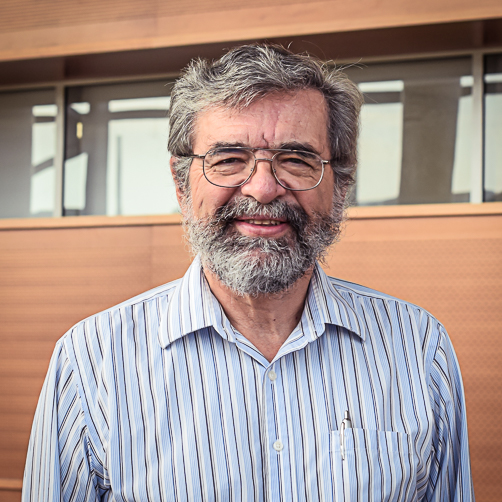
H. Bernhard Schlegel
Distinguished Professor, Emeritus
313-577-2562
313-577-8822 (fax)
Chem 375
Website(s)
Department
Chemistry
H. Bernhard Schlegel
Research interest(s)/area of expertise
Development and application of methods for exploring potential energy surfaces for chemical reactions using molecular orbital calculations
Research
With theoretical calculations it is possible to investigate details of chemical reactions and molecular properties that are often difficult to study experimentally. Molecular orbital computations can be used to explore potential energy surfaces for reactions, determine equilibrium geometries, locate transition states, follow reaction paths and choose between different proposed reaction mechanisms. Heats of formation, NMR spectra, vibrational spectra and a variety of molecular properties can also be calculated reliably by ab initio molecular orbital methods. These calculations are particularly useful for highly reactive molecules and unstable intermediates that are problematic to observe experimentally.
Our lab is involved in both the development and the application of new methods in ab initio molecular orbital (MO) theory. The development efforts are centered around analytical energy derivatives and the use of these derivatives to explore potential energy surfaces. Over the past 30 years, our group and others have developed efficient computer programs to calculate energy derivatives for a variety of levels of ab initio MO theory. Our current efforts include the development of new algorithms using derivatives for geometry optimization, searching for transition states and following reaction paths. We have devised efficient code to compute classical trajectories for molecular dynamics directly from the MO calculations. To aid in the study of radicals, we have developed spin projection methods to obtain more accurate energetics for open shell systems.
The remarkable advances in quantum chemical software and the rapid increase in the speed of computers have opened new realms of chemistry for investigation by ab initio molecular orbital methods. Many of our applications of quantum chemical calculations are in direct collaboration with experimental groups in order to maximize the benefits of our studies. In the area of bio-organic chemistry, we have been looking at oxidative damage to DNA with Cynthia Borrows (U. of Utah), specifically processes involving guanine oxidation. In the area of materials and inorganic chemistry, we have a long standing association with the Winter group investigating precursors for chemical vapor deposition (CVD) and atomic layer deposition (ALD). We are working closely with the Verani and Endicott groups on solar energy conversion and water splitting catalysts. Within physical chemistry, we are studying reaction path branching by ab initio molecular dynamics (AIMD) methods. In collaboration with Wen Li, we are using AIMD to investigate the behavior of molecules in intense laser fields.
Education
- B.Sc., University of Waterloo, Canada, 1972
- Ph.D., Queen’s University, Canada, 1975
- Postdoctoral Fellow, 1976, Princeton University and 1977, Carnegie-Mellon University
- Postdoctoral Fellow Industrial, 1978-80, Merck, Sharp and Dohme
Selected publications
- Lee, M.-K.; Hoerner, P.; Li, W.; Schlegel, H. B.; Effect of spin-orbit coupling on strong field ionization simulated with time dependent configuration interaction. J. Chem. Phys. 2020, 153, 244109 ( https://doi.org/10.1063/5.0034807)
- DeMent, P.; Wakpal, J.; Liu, C.; Schaugaard, R. N.; Schlegel, H. B.; Nguyen, H.; Phenanthroline-Catalyzed Stereoselective Formation of alpha-1,2-Cis 2-Deoxy-2-Fluoro Glycosides. ACS Catal. 2021, 11, 2108-2120 (https://dx.doi.org/10.1021/acscatal.0c04381)
- Bach, R. D.; Schlegel, H. B.; The Bond Dissociation Energy of the N-O Bond, J. Phys. Chem. A 2021, 125, 23, 5014–5021 (https://dx.doi.org/10.1021/acs.jpca.1c02741)
- Schaugaard, R. N.; Nguyen, H. M.; Schlegel, H. B.; Alkyl Radical-Free Cu(I) Photocatalytic Cross-Coupling: A Theoretical Study of Anomerically Specific Photocatylzed Glycosylation of Pyranosyl Bromide. Inorg. Chem. 2021, 60, 12801–12812 (https://doi.org/10.1021/acs.inorgchem.1c01038)
- Hoener, P.; Li, W.; Schlegel, H. B.; Sequential double ionization by strong laser field simulated with time dependent configuration interaction. J. Chem. Phys. 2021, 155, 114103 (https://doi.org/10.1063/5.0060365)
- Schlegel, H. B.; Ab Initio Direct Dynamics. Acc. Chem. Res. 2021, 54, 3749–3759 (https://doi.org/10.1021/acs.accounts.1c00390)
- Basnayake, G.; Hoener, P.; Mignolet, B.; Lee, M. K.; Lin, Y. F.; Winney, A. H.; Debrah, D. A.; Popaj, L.; Shi, X.; Lee, S. K.; Schlegel, H. B.; Remacle, F.; Li, W. Ellipticity Controlled Dissociative Double Ionization of Ethane by Strong Fields. Phys. Chem. Chem. Phys. 2021, 23, 23537-23543 (https://doi.org/10.1039/D1CP03585A)
- Bach, R. D.; Schlegel, H. B.; The Mechanism of Orbital Interactions in the Sharpless Epoxidation with TI (IV) Peroxides. A DFT Study. J. Phys. Chem. A 2021, 125, 10541–10556 (https://doi.org/10.1021/acs.jpca.1c08447)